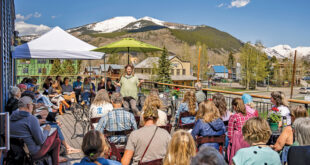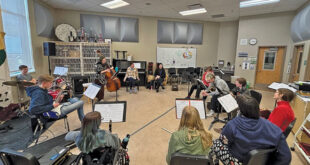By Mark Reaman
Name: Lian Canty
Occupation: Artist, calligrapher, master framer, degree in art from Rocky Mountain College of Art and Design, certified framer from Professional Picture Framers Association
Is this your first Mountain Express bus that you have painted?
This is my first Mountain Express bus!
Why now?
While attending Rocky Mountain College of Art and Design, where I earned my degree in art, I got to know the crew in the sign painting department. After spending a modest amount of time in their “garage” where 1 Shot Enamel, the industry standard, was used because of its durability, to paint outdoor signs, murals, and custom car detailing, I realized how toxic the paint is. For that toxic reason, I had always shied away from painting a bus. Eventually, I got over my own toxic fears and accepted the thought of wearing a VOC (volatile organic compounds) mask to protect me from the fumes inherent in painting a bus and submitted a bus design for a short condo bus. Mountain Express approved my design more than a year ago, but wanted it on a big bus. I agreed to wait for a BIG bus to paint.
How did you come up with the idea?
I approached the design from what I know best, where my interests lie, and what would be the most colorful. Over the years in Crested Butte I have created a number of wildflower paintings and prints, including the 1994 Wildflower Festival poster and a collection of Wildflower Bouquets.
You’ve always been associated with flora in your art but with more formal and historical botanicals. Is this a new branch of that artistic passion?
I started drawing and painting detailed wildflower botanicals to promote the “Antique Botanical Exhibit & Sale,” which was an annual event hosted by me and my ex-husband’s Rendezvous Gallery in conjunction with Turner Art Gallery in Denver. The exhibit and sale featured, at the time, Turner’s extensive collection of antique botanicals, some dating back to the 1700s, as a fundraiser for the Wildflower Festival from 1991 to 2000. I created a yearly hand-colored print of local wildflowers in the traditional style of botanicals during the “Golden Age of Botany” when artists exquisitely documented flora and fauna, before photography was invented. I enjoyed creating these detailed botanicals and learning about the wildflowers.
After a time, I embraced my other artistic love, namely the human figure, creating the “Tree-People”-inspired alphabet and publishing Alphabet Menagerie, the Crested Butte Debut and a series of oil paintings with hidden figures and floral patterns. Most recently I have returned to botanicals with “An Alpine Botanical Collection” where I realized, through the process of creating it, half of my enjoyment painting them is in the adventure of seeking them out and absorbing where these miraculous wildflowers survive.
The bus gave me an opportunity to convey to others my own awe of our splendid wildflowers!
The colors are pretty amazing. Was it difficult to achieve that brightness?
The 1 Shot colors are inherently vibrant, so to create depth and contrast, I used the paint straight out of the can and then blended the different colors together quickly, using a wet-on-wet technique. In this way I created depth and contrast. This technique forced me to focus on a small area at a time, stroking and blending the wet paint before it started to set up and streak. Timing was crucial. I was very pleased with the saturated and brilliant effect on the flowers.
How did you choose the flowers to use?
Some of the flowers I chose to put on the bus are iconic wildflowers that are easily recognizable such as the Blue Columbine, Scarlet Gilia, Lupines, and Indian Paintbrush.
Others are my favorites for various reasons. I included Corn Lilies and Fireweed in honor of local folklore. Local folklore claims that the height of these two flowers during the summer foretells the depth of snow for the coming winter. Thus they are the full height of the bus, inviting plentiful snowfall during winter. One flower, the Pond Lily, gives me much joy, not just for its bold presence floating on high mountain ponds, but also for the salamanders that live under its broad leaves, whose gills are feathery fascinations to me.
And then how did you decide to arrange them on the bus?
The arrangement on the bus took a couple of redrafts. After the bus was sanded, I sketched the flowers onto the bus using dry pastels. In this way I could relocate flowers easily. Eventually, I realized the detailed flowers like the Elephant Head and Glacier Lilies needed to be sidewalk-side so people would be able to see their intricacies as they entered the bus. The bolder flowers and clustered flowers like the Wild Rose lent themselves to being on the back of the bus or highway side. However, I did scale up the Shooting Stars and Harebell to be recognizable at a distance on the highway side.
You have also done a lot of human forms in your art—are there any hidden surprises we should look for in this piece?
There are hidden surprises on and in the bus. Beyond the 30 wildflowers, there is a tabby cat, an invasive flower, bees, a ladybug, three dragonflies, a butterfly, a salamander, a snake, and my favorite creature, that brings me luck (I think). Also, at the request of my dad, Del (actually he insisted), I put a certain detail on the bus. You will, however, need to view the bus from the top to see it.
Did you have help with the painting?
When you paint a bus, you know who your true friends are. The “worker bees” and the Ladybug on the bus are in recognition of the help I had painting the bus. Rich Driscoll and Seth Samson helped with the dusty job of sanding the bus. Lisa Lenander joined the crew to help paint the blue and green background colors, allowing me to focus on painting the flowers, leaves, creatures, and bugs. Henrietta Raines made a guest appearance to help Lisa and me decorate the inside of the bus.
With this great crew offering help and encouragement, the bus was completed in biblical time, 40 days (and nights). The first 12 days were spent sanding and prepping the bus. The next 24 days were filled morning ‘til night with painting. The final four days the finishing touches and sealing the bus were done.
Was it fun to use a bus as a canvas? Or did it present challenges not expected?
I have painted a few murals in town: the KBUT mural, the Titans logo at Crested Butte Community School in the original gym, to name a couple, but nothing as dimensional or exciting as the bus. From conceptualizing the design, to ordering the paint, to the last details of painting it, I was totally immersed in the bus. I was completely stimulated and in my element. Big projects are, for me, why I am an artist. Day after day I loved palleting my brushes, blending the colors, creating depth, brush stroke by brush stroke. Blissful, Zen-like hours flew by.
It was thrilling to create a multi-paneled, moving mural that hopefully will be circulating around town for the next 15 years. As I painted I thought about the iconic buses from the past: Kate Seeley’s fish bus, Carol Connor’s dog bus, and others. I reflected on how they added to the uniqueness of the town. As far as I know, Mountain Express has the only fleet of hand-painted public buses in Colorado.
What are some of the details that I might not see or appreciate unless I look closer?
Because so many of my friends are botanists, I had to include the common and Latin names for all the flowers on the bus. Hopefully this detail will help people identify the flowers and gain a certain reference for the Latin names. On the inside of the bus, among the cloth flowers, are the 10 Mountain Manners, which is intended to help locals and tourists consciously enjoy the outdoors together. And again, there is another surprise on the inside of the bus.
Is that your pet?
The tabby cat is not my dog Suni. Incidentally, I’ve been told that the tabby has acquired the name Hank and a bit of mythos surrounds him, which I would love to hear more about!
Anything else?
I have to say, the bus has been one of my many local art projects, but the one that really excites people. It is gratifying to me. After all, people don’t need to go into galleries to view original art—they just need to hop on the bus!
 The Crested Butte News Serving the Gunnison Valley since 1999
The Crested Butte News Serving the Gunnison Valley since 1999


